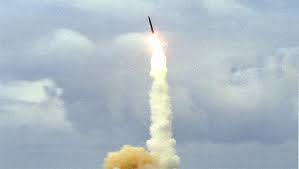KMUN General Assembly Biweekly Edition I - No Right Hands for Wrong Weapons
A Human-centered Rethink of Nuclear Self-Defence by Nkatha Murithi
“Peace is not merely the absence of war, but the presence of justice, of law, of order in short, of government.”
-Albert Einstein.
When Security Becomes a Threat: Rethinking Nuclear Power and the Right to Self-Defence
Introduction
There’s an uncomfortable truth at the heart of modern international law: sometimes, the very frameworks meant to protect human life are used to justify its destruction. My goodness is that one catastrophic paradox!
Nuclear weapons, cloaked in language like "deterrence" and "self-defence," remain among the greatest threats to global peace and human dignity. Former UN Secretary-General Ban Ki-moon, a tireless advocate for nuclear disarmament, once said: “There are no right hands for wrong weapons.” His words echo decades of global struggle against the normalization of nuclear power as a legitimate tool of national security.
In this paper, I examine how the right to self-defence under Article 51 of the UN Charter is increasingly stretched, misinterpreted, and sometimes manipulated especially in contexts involving nuclear weapons. Beyond the legal arguments, this is a human issue: about people, places, and lives that remain vulnerable in the shadow of nuclear power posturing.
Historical Context: The Evolution of Self-Defence in International Law
The idea of self-defence in international law is as old as state sovereignty itself. In the aftermath of the devastation caused by two World Wars, the UN Charter (1945) sought to curtail unilateral uses of force. Article 2(4) strictly prohibits the use of force against the territorial integrity or political independence of any state.
However, Article 51 carved out an exception: allowing states to defend themselves if an armed attack occurs. The hope was to create a global system where war was the exception, not the rule. Yet, as history shows, this balance has proven fragile.
The Cold War era witnessed an increase in anticipatory self-defence rhetoric. The Cuban Missile Crisis (1962) pushed the world to the brink of nuclear annihilation, making deterrence and preemption part of strategic discussions. Later, the 1981 Israeli airstrike on Iraq’s Osirak nuclear reactor reignited debates on what constitutes a legitimate threat.
Scholars like Antonio Cassese warned that stretching self-defence to include anticipatory strikes eroded the international order the UN sought to build. The legal ambiguity surrounding Article 51 remains a live issue today especially as nuclear states assert broader interpretations of their right to "defend" against perceived threats.
Case Studies: When Self-Defence Claims Cross the Line
Israel’s Strike on Syria (2007)
Israel’s bombing of Syria’s alleged nuclear reactor site again tested international legal limits. The absence of an actual attack raised the question: when does “prevention” become unlawful aggression?
North Korea’s Nuclear Justifications
North Korea frequently frames its nuclear program as a matter of self-defence. Yet, its tests and aggressive rhetoric destabilize an already tense East Asian region.
These cases reflect how nuclear threats, real or perceived, often push states to reinterpret self-defence beyond its intended scope.
Russia v Ukraine (2022 to 2025): The Danger of Nuclear Threats in Modern Conflicts
The ongoing Russia-Ukraine war offers one of the most glaring recent examples of how the language of self defence can be manipulated to justify aggression. Russia’s 2022 invasion of Ukraine was framed as a protective response to NATO expansion and alleged threats to Russian speaking populations in Eastern Ukraine. Beyond the breach of territorial sovereignty under Article 2(4) of the UN Charter, Russia’s repeated nuclear threats have set a dangerous precedent. President Putin and key officials have invoked the possible use of nuclear weapons, framing it as a necessary deterrent to protect Russia’s territorial integrity. Yet, the human cost on Ukrainian civilians’ displacement, destruction, and loss of life continues to deepen. The paralysis of the UN Security Council, largely due to Russia’s veto power, further exposes how geopolitical interests can cripple international legal mechanisms meant to uphold peace.
Most recently; Iran and Israel (2024 to 2025): Anticipatory Self Defence on the Edge
In 2024 and 2025, escalating tensions between Iran and Israel highlight how anticipatory self defence arguments continue to stretch the boundaries of Article 51. Israel conducted targeted strikes on Iranian nuclear facilities, justifying them as preemptive acts to neutralize imminent threats. Iran retaliated with drone and missile attacks, framing its response as lawful self defence. Yet, the legality of both sets of actions remains highly contested. The absence of a confirmed armed attack prior to Israel’s strikes raises serious concerns about proportionality and necessity. Meanwhile, the lived reality for civilians on both sides which is fear, loss, and uncertainty often gets drowned out in global strategic narratives. This case evidently underscores the urgent need to revisit how international law interprets threats, especially when nuclear capabilities are involved.
Interpreting Article 51: Legal Frameworks and Grey Areas around the same
Article 51’s wording leaves room for both clarity and dangerous ambiguity. It explicitly refers to armed attacks as the trigger for self-defence. However, several states and scholars argue that "imminent threat" should suffice opening the door to pre-emptive and anticipatory self-defence doctrines.
Dinstein’s writings on self-defence acknowledge that in nuclear contexts, waiting for an actual attack may be catastrophic. Yet, this logic simultaneously undermines the Charter’s goal of preventing war.
The ICJ’s Nicaragua v United States case (1986) emphasized that self-defence must meet necessity and proportionality standards. But how proportional can any response involving nuclear weapons really be?
Judge Christopher Weeramantry, former Vice-President of the ICJ and lifelong advocate for peace, argued that nuclear weapons by their very nature cannot meet humanitarian or proportionality requirements under international law.
Humanitarian Costs Borne; Voices from the Shadows of Nuclear Policy
The legal debate often forgets the people most affected. Survivors of Hiroshima and Nagasaki, known as hibakusha, continue to share their testimonies of unimaginable suffering generational illnesses, displacement, and emotional trauma.
Communities in the Marshall Islands still suffer from radiation exposure decades after U.S. testing. Many Pacific Islanders were not even aware they were being exposed at the time.
Ibrahim Gambari, a Nigerian diplomat and former UN Under-Secretary-General for Political Affairs, highlights that global disarmament efforts often ignore voices from the Global South those historically marginalized in global security dialogues.
Their stories make one thing clear: the human cost of nuclear weapons does not stop with the mushroom cloud. It lingers silently, generationally and unjustly.
Why This Debate Still Matters
The Russia-Ukraine war (2022–2025) brought nuclear threats back into daily news cycles. Russia’s thinly veiled warnings of potential nuclear use revived Cold War-era fears.
Similarly, tensions on the Korean Peninsula and disputes over Iran’s nuclear program show that the risks of misinterpretation or escalation remain dangerously high.
Recent UN Security Council debates reveal how geopolitical interests continue to distort the application of international law. Major powers wield vetoes to protect their actions, while smaller states are often left with little recourse.
If the global legal community does not urgently address these discrepancies, the gap between the law and lived reality will only grow.
Proposals for Reform: Legal, Moral and Practical Pathways
To prevent further abuse of Article 51 and ensure nuclear disarmament progresses meaningfully, the international community must act on multiple fronts:
1. Revising Article 51 Language
The Charter should be updated to clearly define "armed attack" and narrow the scope for anticipatory self-defence, especially in nuclear contexts.
2. Strengthening the ICJ’s Role
UN member states should grant the ICJ more binding jurisdiction over cases involving nuclear threats and the use of force.
3. Enforcing the Treaty on the Prohibition of Nuclear Weapons (TPNW)
Adopted in 2017, the TPNW is a step in the right direction but lacks universal acceptance. Major nuclear powers remain outside its framework. Advocacy and diplomatic pressure must increase.
4. Centering Victim Testimonies
International legal processes should give greater space to voices from affected communities, especially from the Global South.
5. Prioritizing Humanitarian Law over Strategic Doctrine
Self-defence doctrines must always be filtered through international humanitarian law standards of proportionality, necessity, and civilian protection
As Ban Ki-moon emphasized in his Five-Point Plan for Disarmament: disarmament is not just a legal goal, it’s a humanitarian imperative.
Conclusion: Reclaiming Peace, Redefining Defence
International law stands at a crossroad. The misuse of self-defence arguments to justify nuclear posturing threatens not just legal integrity but the lives of millions.
True security is not built on threats, but on justice, accountability, and human dignity. As Mary Ellen O’Connell reminds us: “Force is not a first resort in law; it is the last and most restricted.”
For the sake of future generations, it’s time to reclaim the original spirit of Article 51 not as a loophole for violence, but as a genuine shield for peace.
Because true peace is not written in treaties or weapon stockpiles but in the quiet safety of lives allowed to flourish, free from fear. And as the Good Book reminds us, we were not given a spirit of fear, but of power, love, and sound mind.
Author: Lynne Nkatha, Contributor to the KMUN Journal – General Assembly Biweekly Edition. Nkatha Muriithi is a second-year law student and public international law enthusiast, avid reader and writer, and human.
📜 Copyright Notice📜
© 2025 Kenya Model United Nations Journal – General Assembly Biweekly Edition.
All rights reserved. This publication may be shared or cited for non-commercial academic, educational, or research purposes, provided appropriate credit is given to the author. Any other form of reproduction, storage, or transmission, whether electronic, mechanical, or otherwise, requires prior written permission from the author. Authors retain moral rights to their work.
⚖️ Disclaimer⚖️
The views and opinions expressed in this article are solely those of the author and do not necessarily reflect the official position of the Kenya Model United Nations, its chapters, or the editorial board of the KMUN Journal. Responsibility for the content lies entirely with the contributing author.





